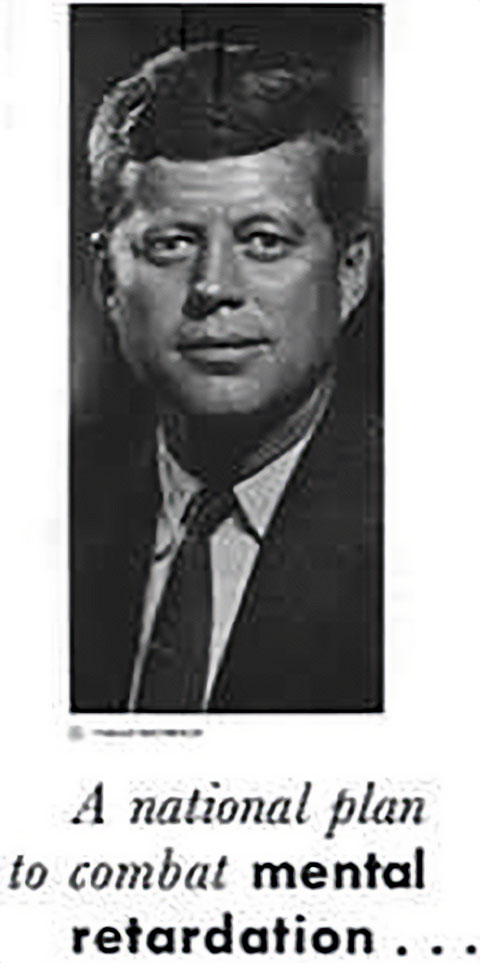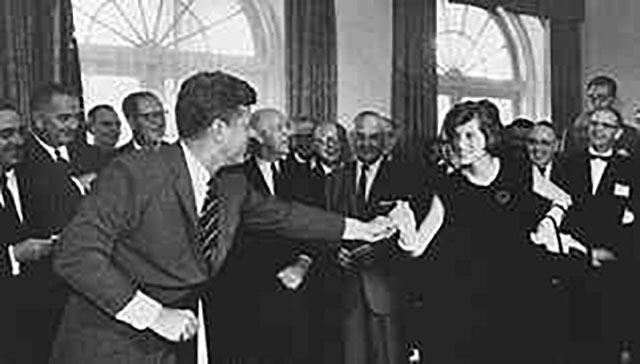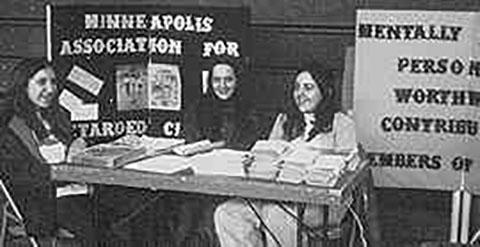"We as a nation have long neglected the mentally ill
and the mentally retarded. This neglect must end…"
–President John F. Kennedy
The Quiet Revolution
The 1960s was a time of great change and societal upheaval in the United States as the Civil Rights Movement continued to address long standing segregation issues - the Freedom RIders in 1961, the March on Washington in 1963, and the Selma to Montgomery March in 1965 that came to be known as "Bloody Sunday." In November 1960, following two terms served by President Dwight D. Eisenhower, Massachusetts Senator John F. Kennedy was elected our 35th President. In one of the closest elections in American history at that time, Kennedy was the first president born in the 20th century.
In January 1963, the Rev. Dr. Martin Luther King, Jr. made his famous "I have a dream speech," proclaiming that "children will one day ...by the content of their character."
A year later, in January 1964, President Lyndon B. Johnson declared an unconditional war on poverty and aspired for a Great Society."
In 1962, a report of the President's Panel on MR, convened by President Kennedy in 1961, concluded that the quality of services in state institutions should be upgraded. Local communities were encouraged to work with federal and state agencies to provide a comprehensive, community-centered continuum of services.
In 1963, federal funds were authorized for the construction of community facilities for people with mental retardation.

President John F. Kennedy
President's Panel on Mental Retardation
The President's Panel of 26 appointed members and chaired by Dr.Leonard Mayo, consisted of outstanding physicians, scientists, educators, lawyers, psychologists, and social scientists. With the exception of Dr. Elizabeth Boggs, who was closely connected with the parents’ movement, Panel members may not have had direct experience with mental retardation as a social issue but each member was influential in his or her respective field. Six task forces were created and charged with conducting an "intensive search for solutions" to the problems experienced by people with mental retardation.
The 1962 Panel report heralded the beginning of federal involvement and fiscal aid to states. The report contained 112 recommendations under the headings of research, preventive health measures, strengthened educational programs, more comprehensive and improved clinical and social services, improved methods and facilities for care, a new legal and social concept of mental retardation, increased educational opportunities to learn about mental retardation, and public education and information programs.
At this time, the medical profession was considered the final authority on mental retardation and other disabilities. Consequently, the Panel included several medical authorities and emphasized prevention and treatment. Their goal was to "combat" mental retardation, "[exploring] the possibilities and pathways to prevent and cure mental retardation."
The report also prompted the development of new legislation. Public Law 88-164 authorized funding for developmental research centers in university affiliated facilities and community facilities for people with mental retardation. Amendments to the Social Security Act (Public Law 88-156) increased services for maternal and child health, and funded studies in each state (first reform report) on the status of services for people with mental retardation. The Panel, unfortunately, was short lived and expired with the Kennedy Administration.
Prior to his assassination on November 22, 1963, President Kennedy promoted several new programs in the areas of disability, civil rights, and education. His successor, Lyndon B. Johnson, assured passage of the Civil Rights Act of 1964, outlawing discrimination based on race, color, religion, sex, and national origin; and the Elementary and Secondary Education Act of 1965, aimed at providing equal education opportunities and addressing achievement gaps especially among disadvantaged students. These Acts represented landmark Congressional actions that were of tremendous importance to persons with disabilities.

The Influence of President Kennedy
President Kennedy's sister, Rosemary, had mental retardation. Until she was in her twenties, Rosemary lived with her family and enjoyed the same lifestyle as her brothers and sister. Like most families during this time, the Kennedy family did not openly discuss having a sibling with mental retardation. By 1962, however, this changed.
The parents' movement had effectively brought mental retardation and other disabilities out into the open. Eunice Kennedy Shriver shared part of Rosemary's story in an article, "Hope for Retarded Children," that was published in the September 22, 1962 edition of the Saturday Evening Post. Read by millions of people, Rosemary's story further convinced parents that having a child or sibling with mental retardation was nothing about which to feel shameful or guilty.

John F. Kennedy and Eunice Kennedy Shriver
President Lyndon Johnson
While the Kennedy administration brought attention to the "problem" of mental retardation, the Johnson administration actually accomplished broad changes for persons with disabilities. President Johnson's civil rights agenda and War on Poverty also affected people with disabilities. The War on Poverty, initiated through the Equal Opportunity Act of 1964, launched such programs as Head Start, the Neighborhood Youth Corporation, and Volunteers in Service to America (VISTA). These programs also indirectly assisted persons with disabilities and their families.
In 1966 by Executive Order, President Johnson created the President's Committee on MR that continues to assure that the national government does not overlook the the problems of public policy and private initiatives related to intellectual disability. In 2003, the Committee was renamed by President George W. Bush as the President's Committee for People with Intellectual Disabilities.
THE YOUTH - NARC
In October 1967, the NARC sponsored a National Youth Conference on MR in Portland, Oregon. Following a second national conference held in October 1968 in Detroit, Michigan, a new national organization, Youth NARC, was created. Its purpose was "to serve as a friend of persons with MR... to help the people learn to live in, work in, and attempt to better his world."
In 1969, Youth-NARC published an orientation handbook which contained the following suggestions for working with adults with disabilities:
Talk to him. Listen to him. Find out what he thinks, how he feels, what he wants to do. Help him be part of the bigger world … encourage him to do everything he can for himself.

At that time, more than 70,000 volunteers between the ages of 13 and 25 were involved in Youth-NARC projects.
While the main focus of Youth-NARC was training volunteers who could work with persons with disabilities, it was discovered that "the retarded themselves may be trained in leadership." While Youth-NARC may be largely forgotten, it had a strong influence on the development of the self-advocacy movement.
Normalization
One of the most important contributions to the disabilities movement was the concept of normalization. In 1959, a group of parents in Denmark organized to petition their government for better treatment of their sons and daughters with mental retardation. Working with Niels Erik Bank-Mikkelsen, they put into very simple terms the concept of "normalization."
The concept did not refer to making people "normal," to make them behave a certain way, but rather to live according to a normal pattern, "making available to [people who are] mentally retarded the patterns and conditions of everyday life which are as close as possible to the norms and patterns of the mainstream of society." Normalization reflected a lifestyle and one dramatically opposed to that of the institutions.
Dr. Bengt Nirje, secretary general of the Swedish Parents Association for Mentally Retarded Children, worked with Bank-Mikkelsen and Karl Grunewald in formalizing the principle of normalization. Dr. Nirje described the Normalization Principle as:
- A normal rhythm of the day (eating, sleeping);
- A normal routine (living, work, school);
- A normal rhythm of year (holidays);
- Normal developmental experiences;
- The chance to make choices;
- The right to live heterosexually (not segregated into "men only" or "women only" accommodations);
- A normal economic standard;
- The right to live, work and play in normal communities.

Bengt Nirje
Denmark and Sweden put the normalization principle into law. Dr. Nirje translated the concept into English and published the concept in the 1969 President's Report on Mental Retardation, where it had a tremendous impact on American professionals.
Since the late 1960s, normalization has been "a deceptively simple concept," often misunderstood and redefined. Influential writers, including Dr. Wolf Wolfensberger, greatly expanded the concept. In his work about "social role valorization," he described the role perceptions of people with disabilities.
The following role perceptions illustrate how our society has categorized and viewed persons with disabilities. But note, these perceptions are neither exclusive nor exhaustive. It is too easy to assume that one stereotype fits a given time or a given disability. Our perceptions are often a combination of many stereotypes and attitudes.
- Persons with disabilities as sick: Those who need to be cured of a dread disease; referred to as patients; in need of professional care in a hospital setting.
- Persons with disabilities as sub-human organisms: Perceived as "animal-like" or "vegetative," or as "garden variety" or cultural-familial retardation; treated like animals in institutions; possessing less than full humanity and not deserving of all human rights; referred to as "so-called human beings."
- Persons with disabilities as menaces to society: Perception that people with disabilities are somehow evil and represent a danger to themselves and to society; this perception leads typically to a concern for and measures leading to the destruction, segregation, containment, control, and persecution of persons with developmental disabilities.
- Persons with disabilities as objects of pity: Seen as suffering from some condition beyond their control, and therefore not considered accountable for their behavior; viewed with a "there but for the grace of God go I" attitude; paternalism and low growth expectations are typical consequences of this viewpoint.
- Persons with disabilities as burdens of charity: Viewed as clients entitled to food and shelter and little else; the disability is often viewed as punishment for some sin, and any help rendered is more from contempt than sympathy; persons with disabilities receiving this "cold charity" viewed as draining public resources, and expected to show proper appreciation.
- Persons with disabilities as holy innocents: Belief that individuals are special children of God, with a special purpose; seen as incapable of committing evil, and sometimes viewed as living saints; often viewed as "eternal children" who will never grow up
While people continue to debate the precise meaning of normalization, the concept's effect on how we view institutions has been significant.
With the acceptance that persons with disabilities could and should live in the community with their own families and as independent adults, the pressure for more and better community services grew in intensity.
By the late 1960s, the potential of community services was clearly demonstrated, and the rationale for the continued existence of large institutions was called into question. The role of parents in organizing, working with and sometimes against "the system," was greater than ever.

In 1980, and in response to the growing parents' movement, Charlotte Des Jardins wrote "How to Organize an Effective Parent/Advocacy Group and Move Bureaucracies". In her book, she offered the following advice:
- You must stop feeling guilty and insignificant.
- You must stop apologizing for asking a bureaucrat to do a job you are paying him to do.
- You must stop begging for what you are entitled to by law.
- You must not accept these old excuses: "There isn't enough money"; "We need more time."
- You must stop whispering when everyone else is shouting.
- Don't be afraid to complain.
- You must use mass action.
Although originally directed at parents, these words are relevant today for all disability advocates and self-advocates.

Charlotte Des Jardins
Gunnar Dybwad On Normalization
Let me say a few words about the normalization principal as it was developed first in Denmark by Niels Erik Bank-Mikkellsen. A very wonderful state administrator in Denmark who had died just two years ago. He had been a person in Danish state administration. When the parents of children with mental retardation petitioned the king to have a committee to investigate the problem of mental retardation and there was such a committee and Mr. Bank-Mikkelsen was the secretary of the committee. and the committee recommended that a service be established.
The king did, and Mr. Bank-Mikkelsen became the head of it. And he began to look at institutions and found to his amazement that in institutions where there were little children, older children, and adults with mental retardation, dinner was served at 3:00 in the afternoon so that the staff could wash the dishes before they left. He found that toilets existed there as they existed nowhere else in Denmark, open toilets without stalls. He found dormitories where people lived in conditions that were not to be seen anyplace.
And he came to the conclusion that these individuals had a right to live under normal circumstances. And he called this the normalization principal, that we should change things so that these individuals could live like other people do.
The Case Management Team: Building Community Connections (1987)
In 1987, the case management planning process was based on what's important to individuals and what families need, and reflected how perceptions and attitudes about people with developmental disabilities changed as a result of the Civil Rights Movement.
[somber flute music]
male narrator: For years, persons with developmental disabilities and their families faced a poverty of alternatives.
[somber flute music]
Society almost always prescribed institutional care for these individuals, ignorant of the role its own negative attitudes and low expectations played in that prescription.
[somber flute music]
Thought of as being less than human…
[somber flute music]
Identified with their handicaps and not their personhood…
[somber flute music]
Persons with developmental disabilities were typically the objects of fear, pity, or ridicule.
[somber flute music]
Victims of a profound misunderstanding in which they were never seen to grow, develop, or change.
[lively music]
The Civil Rights Movement brought a new perspective. Families of persons with developmental disabilities began to organize. Parent advocacy grew.
Court decisions specifically addressing the legal status of persons with developmental disabilities multiplied and the individual achievements of a growing number of persons with developmental disabilities shaped more mature attitudes, and with the spread of these attitudes began the movement towards smaller facilities located within the mainstream community.
In time, parents and professionals both came to question whether the mere presence of persons with developmental disabilities in a community improved their quality of life, advanced their interests or those of their families.
It was not enough to be physically in a community but not really part of it. In 1975, federal law established that children with developmental disabilities had a right to free and appropriate education in the least restrictive setting.
This gave families the option to refuse out-placement and to keep their children living at home. Those children with developmental disabilities who received appropriate public education who remained at home with their families or lived in home-like environments attained a level of achievement far beyond those who had been institutionalized with these results in hand, it became clear to more and more parents and professionals that the major problems were restrictive and sterile environments, not the disability; negative attitudes and low expectations, not the handicap.
Lack of appropriate skill in providing services, not the person. What was missing from the equation was not care but the quality of care.
[somber flute music]
More and more professionals and families began challenging the old views. They began asking, "What would happen if persons with developmental disabilities learned how to make choices about their lives; they lived in places they could really call home; they were taught the practical skills needed for everyday situations; they enjoyed the company of friends?"
They began to suspect that the value of broad experience, varied experience, rich experience was as great for the person with developmental disabilities as it is for any human being.
Experience that afforded learning, independence, integration. These are the goals of quality case management when it comes to improving the lives of persons with developmental disabilities.
Today case management concerns itself more with what an individual is capable of achieving and less with what his or her limitations happen to be. Case management is about rising expectations, arrangements that reflect what the person with developmental disabilities thinks or feels is important, family needs, and individualizing services to help transform hopes into reality.
Case management is available to anyone with mental retardation or other developmental disabilities provided that the person, his or her family or legal representative applies for it at the county social service department, and the department establishes that person's eligibility.
Effective case management demands a close partnership among the case manager, the person with developmental disabilities, and his or her family or legal representative.
From the very beginning, it has to be a team effort. While the case manager is the team leader, decision making is participatory, and the person with developmental disabilities must be present whenever the team is making service decisions unless his or her medical condition prevents this.
Of course, other professionals may join the team whenever the need arises for more information or specialized expertise. Case management is a five-part process involving assessment, planning, monitoring, evaluation, and advocacy.
To understand what happens in each of these phases, let's explore the case management process in a little more detail. During the assessment phase, the team collects information to determine what services or arrangements the person with developmental disabilities will need in order to lead as integrated and as fulfilling a lifestyle as possible.
What we would like is your input as to what you think, you know, you wanna see for Brian in the future residentially and vocationally. What you see as Brian's strengths, that's really what we wanna build on is what Brian can do.
narrator: In the planning phase, the team reaches consensus on all the services needed and the case manager sets up the arrangements discussed in the assessment phase.
One result of this phase is an individual service plan or ISP, which reflects the assessment summary, goals, objectives, and all service expectations the team has defined for the person with developmental disabilities with as much of that person's participation in the process as possible.
Andrea, could you give us an idea of what your vocational program has to offer and how it could be fitted into Brian's life?
Well, our program has a lot to offer in the way of training one-to-one if he needs that on a large scale or a small scale since we have a large workroom and a small workroom, and, after he receives that training, he can utilize that on an enclave in the community and, perhaps later down the line, be an independent and getting to his job independently and using that independently.
narrator: Next, the case manager draws up an individual habilitation plan or IHP. This breaks down the services listed in the ISP in terms of how each will fulfill the person's goals.
This is the phase that sets the stage for the transition to a more integrated style of life, a higher quality of life for the person with developmental disabilities. In the monitoring phase, the case manager spearheads a process designed to make sure that the services specified in the ISP are working as planned…
Hi, Andrea, how are you today?
I'm fine, Candy, thank you. How are you?
Good, I thought I'd come out today and observe Brian at work.
Good, he's working on headsets right now. Just follow me, and I'll take you where he's at.
narrator: And shares this information with the person with developmental disabilities and the other members of the team.
Our meeting today is an evaluation of Brian's past year, and what we want is input from both of Brian's providers--residential and vocational.
narrator: Evaluation occurs at least once a year, more often if necessary, and concerns the progress the person with developmental disabilities is making toward achieving the stated goals.
It's just remarkable what he's accomplished, and I think a lot of it had to do with having a consistent director staff person and a lot of assistance in coordinating some training for him. I really see where he's so bright we have to make it even more challenging.
narrator: Advocacy is often ongoing. With every member of the team prepared to stand up for the best interests of the person developmental disabilities. The purpose of this phase of the case management process is to seek solutions should problems arise, fill gaps in service if they develop, or overcome whatever other obstacles may arise to prevent the person's continued process toward greater independence and integration into the community.
It's a process that demands the maximum possible participation of all team members including the person with developmental disabilities and his or her family. The entire process, from assessment through advocacy, begins when the person with developmental disabilities or the family applies for and receives case management services.
Case management is the administrative tool that paves the way to a broad range of individualized services--services designed specifically for a particular person with developmental disabilities and suited to that person's individual needs and circumstances.
Families need to know that obtaining individualized services may not be easy. Their availability depends on the creativity of the case manager, the ingenuity of the service providers, and the sensitivity of the social service agencies involved.
There's no way to know for sure how long or how complicated the process of securing individualized services will take in every instance. It may be necessary to be persistent, assertive, or even confrontive in order to accomplish this.
Despite the fact that the right to individualized services is protected by case management regulations, for many families, it can become a protracted struggle bringing them into conflict with social service authorities, elected officials, and government bureaucrats.
Often it helps to have the support of one of the growing number of volunteer groups dedicated to the cause of persons with developmental disabilities
[somber flute music]
Is quality case management worth the effort? Ask any of these people, but we think you already know what the answer will be.
[uplifting piano music]
